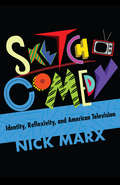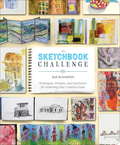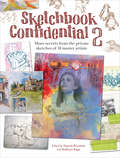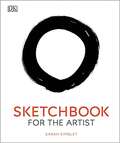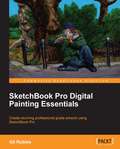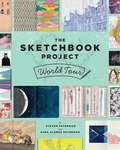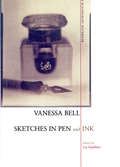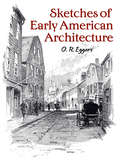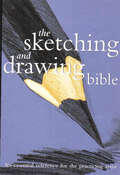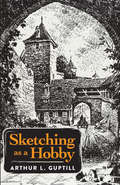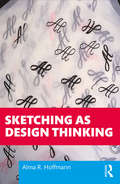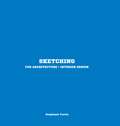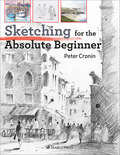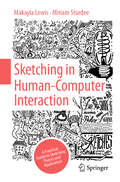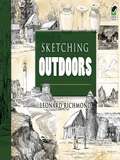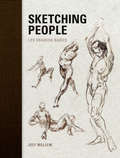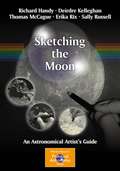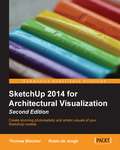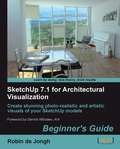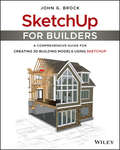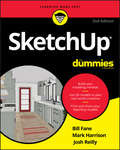- Table View
- List View
Sketch Comedy: Identity, Reflexivity, and American Television
by Nick MarxA history of sketch comedy on American television and analysis of what it says about American culture and society.In Sketch Comedy: Identity, Reflexivity, and American Television, Nick Marx examines some of the genre’s most memorable?and controversial?moments from the early days of television to the contemporary line-up. Through explorations of sketches from well-known shows such as Saturday Night Live, The State, Inside Amy Schumer, Key & Peele, and more, Marx argues that the genre has served as a battleground for the struggle between comedians who are pushing the limits of what is possible on television and network executives who are more mindful of the financial bottom line. Whether creating new catchphrases or transgressing cultural taboos, sketch comedies give voice to marginalized performers and audiences, providing comedians and viewers opportunities to test their own ideas about their place in society, while simultaneously echoing mainstream cultural trends. The result, Marx suggests, is a hilarious and flexible form of identity play unlike anything else in American popular culture and media.“An excellent study of a long-neglected area in television/media studies and is part of a larger turn toward the centrality of comedy in post-war U.S. culture.” —Jeffrey Sconce, Northwestern University“A stalwart of television . . . sketch comedy finally gets the in-depth critical attention it deserves . . . Marx shows how sketch comedy has fit (and been constrained by) TV’s industrial contexts, from live variety shows in its earliest days to movement across media in the era of multiple platforms. These case studies not only chart sketch comedy’s past, they provide the theoretical and analytical tools to consider its future.” —Ethan Thompson, Texas A&M University Corpus Christi
The Sketchbook Challenge: Techniques, Prompts, and Inspiration for Achieving Your Creative Goals
by Sue BleiweissHave you ever bought a new sketchbook, opened to the first page, and thought, "Now what do I do?" Sue Bleiweiss and the talented minds behind The Sketchbook Challenge are here to help. Imagine a supportive community of artists sharing the innermost pages of their sketchbooks and offering you tips and techniques for overcoming creative blocks. That's what The Sketchbook Challenge is all about, and the popular blog of the same name has already inspired thousands. Inside this book, you'll find: · Themes that will motivate you to start your sketchbook--and, more important, keep at it · Tutorials spotlighting such mixed-media techniques as thread sketching, painted papers for collage, digital printing, and much more · Strategies to get off the sketchbook page and start creating inspired art--whether you're into painting, collage, fiber art, or beyond. · In-depth profiles of artists who have taken the Sketchbook Challenge and used it as a launching pad for their own meaningful artwork
Sketchbook Confidential: Secrets from the private sketches of over 40 master artists
by Editors of North Light BooksPulsing with ideas, energy and inspiration, Sketchbook Confidential offers a rare peek inside the personal sketchbooks of 40+ master artists. From colorful painted sketches to spontaneous napkin doodles, from the intensely personal to the purely whimsical, most of the work here was produced quickly and never intended for public view. It is honest and immediate, fresh and fearless.In their own words, the artists share the intentions and inspirations behind their sketching. For some, it is a cherished, everyday habit - a way of wandering through the ideas in their mind, playing around with new subjects, or just having some anything-goes kind of fun. For others, sketching is a deliberate tool for problem-solving - working through a composition, capturing a moment's light or test-driving a color scheme.As you turn the pages you'll be immersed in the creative processes of these individuals, arriving on the other side with a feeling of kinship and a renewed desire to boldly capture life in your own sketchbooks!
Sketchbook Confidential 2: Enter the secret worlds of 41 master artists
by Pamela Wissman Stefanie LaufersweilerMore secrets from the private sketches of 38 master artists The idea may be derived from anything really--a flash of sunlight, the tilt of a head, a glass on the table...but the sketch is where it all begins, the point where inspiration meets artist. Gloriously free of the need to get it "right," the sketch is where possibilities are explored, compositions are found, and visions come to life. A brilliant follow-up to the first Sketchbook Confidential, this book grants you access to 38 of art's most creative minds via their sketchbooks. Whether created in studios, subways or the middle of a farmyard, these sketches represent art in its raw form. Up until now, this work has been tucked inside drawers or on studio bookshelves. Now the artists lay it out for all to see, along with intimate musings on the art of sketching and how it helps them commune with a subject, find their path to a finished piece or discover even greater rewards in the journey itself.
Sketchbook For The Artist: An Innovative, Practical Approach To Drawing The World Around You
by Sarah SimbletDevelop your drawing skills and rediscover the world around you with this innovative and beautifully illustrated book. In Sketch Book for the Artist, acclaimed artist and teacher Sarah Simblet teaches you how to draw by combining practical lessons with examples of both her own work and some of the world's greatest drawings. She introduces all the key drawing materials, then shows you how to master the basic elements of drawing in a series of step-by-step drawing classes, covering topics ranging from simple mark-making to establishing form, creating tone, and conveying perspective. You will learn how to explore a wide variety of subjects, from still life, plants, and animals to portraits, the human body, landscapes, and buildings, all of which are introduced with outstanding drawings by famous artists. The bestselling author of Anatomy for the Artist and Botany for the Artist, Sarah demonstrates how she works - from quick pencil sketches to pen and ink studies - with expertise and plenty of encouraging tips, and complements them with plentiful examples from her own drawing books. Sketch Book for the Artist is for anyone who wants to draw, whether you are a complete beginner or would like to refresh your existing skills. Whatever your ability, it will inspire you to reach for a pencil and paper and start drawing.
Sketchbook Pro Digital Painting Essentials
by Gil RoblesThis book is an example-based guide that will help you create professional grade paintings using Sketchbook Pro. As you progress from one chapter to another, you will learn how to virtually draw visually stunning paintings that are digitally drawn but look exactly like orthodox artwork.If you have had prior experience in developing digital artwork and are looking to add to your knowledge, Sketchbook Pro Digital Painting Essentials is a guide that will help you seamlessly translate what you do with traditional media to digital media.
The Sketchbook Project World Tour
by Steven Peterman Shane ZuckerDestined to go down as one of the era's most astonishing global art projects, the Brooklyn Art Library's Sketchbook Project has, in less than a decade, amassed more than thirty thousand sketchbooks submitted by people of all ages and artistic abilities from more than 130 countries. Bursting with color, vivid imagery, and bouts of whimsy mixed with deeply intimate insights, the sketchbooks capture the texture of personal experience in a dizzying variety of illustrative styles and layouts that run the gamut from street portraits to stream-of-consciousness doodles, comics, and pop-ups. The Sketchbook Project World Tour presents the most compelling, surprising, and visually stunning examples from this one-of-a-kind artistic treasury.
The Sketchbook War: Saving the Nation's Artists in World War II
by Richard KnottDuring the Second World War, British artists produced over 6,000 works of war art, the result of a government scheme partly designed to prevent the artists being killed. This book tells the story of nine courageous war artists who ventured closer to the front line than any others in their profession.Edward Ardizzone, Edward Bawden, Barnett Freedman, Anthony Gross, Thomas Hennell, Eric Ravilious, Albert Richards, Richard Seddon and John Worsley all travelled abroad into the dangers of war to chronicle events by painting them. They formed a close bond, yet two were torpedoed, two were taken prisoner and three died, two in 1945 when peacetime was at hand. Men who had previously made a comfortable living painting in studios were transformed by military uniforms and experiences that were to shape the rest of their lives, and their work significantly influenced the way in which we view war today.Portraying how war and art came together in a moving and dramatic way, and incorporating vivid examples of their paintings, this is the true story behind the war artists who fought, lived and died for their art on the front line of the Second World War.
Sketches In Pen And Ink: A Bloomsbury Notebook
by Vanessa BellVanessa Bell, artist, sister of Virginia Woolf, wife of Clive Bell and lover of Duncan Grant, is one of the most fascinating and modern figures of the Bloomsbury set, but unlike most of them she rarely put pen to writing paper. When she did, she was witty and illuminating about their early lives. The eldest of the Stephen family, she grew up with Virginia in Victorian gloom at Hyde Park Gate and later blossomed in bohemian style in Bloomsbury. From the twenties to the forties she lived and painted at Charleston Farmhouse like a heroine of the sixties and seventies, at the centre of a colourful world of family, friends, artists and intellectuals. Sketches in Pen and Ink is a unique collection of largely unpublished memoirs - most of them written to be read at meetings of the Memoir club, in which Vanessa writes with wit and charm about herself, her childhood, her remarkable family and friends, her moving relationship with Roger Fry, and her art. Her daughter, Angelica Garnett, has written a vivid and personal introduction which adds considerably to our understanding of this extraordinary woman and artist.
Sketches of Early American Architecture
by William H. Crocker O. R. EggersThese 53 magnificent drawings by a distinguished architect recapture landmarks of colonial America. Originally published in 1922, Otto Reinhold Eggers' portfolio of pencil sketches depicts historic structures in New York, Philadelphia, Boston, and Baltimore as well as those of smaller towns in Connecticut, Virginia, and elsewhere. Images of churches, municipal structures, homes, and other architectural gems range from the majesty of St. Paul's Chapel, Manhattan's oldest surviving church, and the grandeur of George Washington's Mt. Vernon residence to a Dutch farmhouse in New Jersey and a Newport street lined with quaint eighteenth-century buildings.Otto Reinhold Eggers (1882 - 1964) was one of the architects of the Jefferson Memorial in Washington, D. C., and his seven-decade career in architecture included a 30-year association with John Russell Pope, first as a draftsman and eventually as a partner. Eggers' meticulously rendered sketches, photographic in their detail and effect, offer fascinating perspectives on some of America's architectural treasures. Extensive captions for each of the illustrations by William H. Crocker, editor of The American Architect, provide fascinating historical background.
The Sketching and Drawing Bible: An Essential Reference for the Practicing Artist (Artist's Bibles Ser.)
by Marylin ScottAn essential and extensively illustrated reference for the practical artist, covering materials, techniques, and subjects.This complete guide to drawing media, from pencils and charcoal to pastels and colored inks, also features:Information on how to achieve exciting and unusual effects by combining two or more drawing mediaOver 100 step-by-step demonstrations showing ways of tackling tricky subjectsSections covering figure, landscape, nature, urban, and still life drawingTips on how to professionally present your work and get it into the marketplace
Sketching as a Hobby
by Arthur L. GuptillTailored to both beginner- and intermediate-level illustrators, this highly enjoyable guide and reference was written by Arthur L. Guptill, co-founder of Watson-Guptill Publications and one of the leading art instruction authors of the twentieth century. Filled with tips, methods, and techniques on outlining, shading, stippling, portraiture, and much more, this fully illustrated introduction will help readers develop their drawing and sketching skills according to their abilities and interests. <p><p> Starting with the representation of forms, values of light and dark, and the interpretation of color, the guide progresses from elementary to advanced considerations, with explanations and illustrations for each step. Pencil, crayon, charcoal, pen and ink, wash, and watercolor techniques are examined, along with a variety of unique methods that achieve original effects. Intended chiefly for enjoyment rather than commercial application, the book focuses on the sketching of objects, outdoor subjects, landscapes, animals, and people. Readers are encouraged to think for themselves and to experiment in order to develop a natural and individual style.
Sketching as Design Thinking
by Alma R. HoffmannThis book argues for the importance of sketching as a mode of thinking, and the relevance of sketching in the design process, design education, and design practice. Through a wide range of analysis and discussion, the book looks at the history of sketching as a resource throughout the design process and asks questions such as: where does sketching come from? When did sketching become something different to drawing and how did that happen? What does sketching look like in the present day? Alongside an in-depth case study of students, teachers, and practitioners, this book includes a fascinating range of interviews with designers from a wide variety of backgrounds, including fashion, user experience, and architecture. Sketching as Design Thinking explains how drawing and sketching remain a prominent aspect in our learning and creative process, and provides a rich resource for students of visual art and design.
Sketching for Architecture + Interior Design: A Practical Guide On Sketching For Architecture And Interior Design Students
by Stephanie TravisThe debate surrounding hand drawing versus computer-generated imagery has become a hot topic. Having grown up with computers, today’s interior design and architecture students are extremely adept at creating computer imagery, but often lack confidence in their freehand sketching skills, or do not know how to sketch at all. Sketching, and the careful observation that it entails, is essential for the successful development of the next generation of designers. Forty-five step-by-step exercises take the student from the simple three-dimensional forms of furniture, to interiors, to complex building exteriors, and cityscapes. Technical topics covered include tools, line weights, perspective, proportion, composition, shading, serial views, and context. Exercises are illustrated with beautiful sketches specially created by the author.Sketching for Architecture + Interior Design is an indispensable and practical guide for students wishing to master the art of looking and sketching.
Sketching for Architecture + Interior Design
by Stephanie TravisThe debate surrounding hand drawing versus computer-generated imagery has become a hot topic. Having grown up with computers, today’s interior design and architecture students are extremely adept at creating computer imagery, but often lack confidence in their freehand sketching skills, or do not know how to sketch at all. Sketching, and the careful observation that it entails, is essential for the successful development of the next generation of designers. Forty-five step-by-step exercises take the student from the simple three-dimensional forms of furniture, to interiors, to complex building exteriors, and cityscapes. Technical topics covered include tools, line weights, perspective, proportion, composition, shading, serial views, and context. Exercises are illustrated with beautiful sketches specially created by the author.Sketching for Architecture + Interior Design is an indispensable and practical guide for students wishing to master the art of looking and sketching.
Sketching for Engineers and Architects
by Ron SladeUsing real working drawings from a 50 year career, Ron Slade shows how drawing remains at the heart of the design process in the everyday working life of engineers and architects. The book explains simple techniques that can be learnt and used to enhance any professional’s natural ability. Using over 180 categorised examples it demonstrates that drawing remains the fastest, clearest and most effective means of design communication. Unlike many other books on drawing in the construction industry, this book is ‘engineer led’ and science oriented but effectively shows that there is a close affinity between the working methods of architects and engineers.
Sketching for the Absolute Beginner
by Peter CroninFrom the author of the best-selling art book, Pure Watercolour Painting and guest judge on Channel 5's Watercolour Challenge, Peter Cronin.Sketching is more than just drawing quickly. It is training your eye and hand to work together, to respond immediately and naturally to the scene before you. Starting from a clear, simple method to bring all the senses into play, successful author and acclaimed artist Peter Cronin shows the reader how to bring artistry and economy to their sketching; making for swift and impressive results. Whether sketching as the basis for painting, or simply for pleasure, this book teaches the reader all they need to know.Numerous simple step-by-step exercises as well as larger projects lead the complete beginner through the book, building towards more complex and rewarding artworks. The book teaches how to sketch with a range of media, starting from graphite pencil and including information and exercises on charcoal, pen and ink and others. In the best-selling Absolute Beginner series, this book is suitable for absolutely everybody who wants to take their sketching skills further and become an accomplished artist.
Sketching in Human Computer Interaction: A Practical Guide to Sketching Theory and Application
by Makayla Lewis Miriam SturdeeSketching is a universal activity that first appears when we play as children, but later, it is often overlooked as a useful skill in adult work – yet it can bring multiple benefits to research and practice in multiple domains. Specifically, Human Computer Interaction embraces interdisciplinary practices, and amongst those, sketching has proven to be a valuable addition to the skill set of researchers, practitioners, and educators in both academia and industry. Many individuals lack the confidence to take up pen and paper after years of non-practice, but it is possible to re-learn these lost skills, improve on them, and apply them in practical ways to all areas of work and research. This book takes the reader on an active journey in sketching: from scribbles and playful interpretations to hands-on practical applications in storyboarding, and further, in examining qualitative analysis using sketching practice in HCI. Readers will learn a wide range of techniques andapplied methods for utilizing sketching within the context of HCI, guided by the experienced authors, and join the larger community of those who employ (and enjoy) sketching in Human Computer Interaction.
Sketching Outdoors
by Leonard RichmondA facility with pencil drawings is a valuable asset for painters in oil and watercolors, and a high-quality pencil sketch ranks as the artistic equal of the best painting. This guide offers beginners step-by-step demonstrations of how to depict clouds, trees, buildings, and other outdoor scenes. <p><p> Famed for his landscape paintings, author Leonard Richmond provides pencil studies that demonstrate each stage of picture-making, from rough sketch to completed work. Students who copy and memorize the simpler studies can advance to the more complicated pictures, attaining skills that will assist them in drawing directly from life or nature. Using a variety of pencil techniques, Richmond shows how to re-create stormy and tranquil skies, foliage, driftwood and rocks along the seashore, and other outdoor scenery. Students will savor the rich diversity of these illustrative landscapes, which include scenes from England's Cornish coast, a homestead in New Mexico, a Vermont meadow, and the French countryside.
Sketching People: Life Drawing Basics
by Jeff MellemLife Lessons: Learn How to Capture a World Constantly in Motion Fluid, fast and expressive life drawing starts here. Step by step, you'll learn to render fleeting gestures from memory, capture expressions simply and more quickly, give your drawing a life of its own with body language, and more. Along the way, you'll develop a more spontaneous approach for successfully working from life. Inside you'll find: A comprehensive course on drawing from life, based on classic principles Essential techniques for drawing gesture, figures, clothing, expression, body language and more Lots of exercises that bring lessons to life The skills you'll learn from this book are so fundamental that every artist will find something in these useful lessons for making the most of all the inspiration that life has to offer.
Sketching the Moon: An Astronomical Artist's Guide
by Sally Russell Deirdre Kelleghan Erika Rix Richard Handy Thomas MccagueFor anyone artistically inclined, observing the Moon and attempting to sketch or paint it can easily become a passion. The Moon presents a broad array of tone, texture, and form. Capturing this in a painting or sketch at the eyepiece of a telescope - or even with binoculars - develops observational skills, leaves a record of the observation, and can also be a delightful and rewarding pastime. However, the choice of media available is extensive (acrylic paint, oils, pen, charcoal, etc., and even computer art programs), and there is no existing text that fully explains all lunar sketching and painting techniques in each respective medium. This beautiful and graphically rich book fulfills this requirement. It presents detailed step-by-step instructions, in the form of illustrated tutorials for every major medium employed to represent the Moon. It also provides practical advice on how to sketch outdoors at night (not ideal conditions for an artist!). This is easily the most extensive book on the subject of lunar art for amateur astronomers, particularly those observing through a telescope. The diverse features of the lunar surface will attract and entice readers to review the number of different media presented, exciting and inspiring them with the possibilities of learning to depict all of the fascinating aspects of Earth's very own satellite.
SketchUp 2014 for Architectural Visualization Second Edition
by Robin De Jongh Thomas BleicherBeginning with a quick start tutorial which will get you up and running with SketchUp 2014 quickly, you will move on to learning the key skills you will need to wow your clients with stunning visualizations through a series practical steps, tips and tricks. If you are a SketchUp user, from an amateur right through to an architectural technician, professional architect, or designer, this is the book for you. This book is also suitable as a companion to any architectural design or multimedia course, and is accessible to anyone who has learned the basics of SketchUp.
SketchUp 7.1 for Architectural Visualization: Beginner's Guide
by Robin De JonghWritten with a fast-paced but friendly and engaging approach, this Packt Beginner's Guide is designed to be placed alongside the computer as your guide and mentor. Step-by-step tutorials are bolstered by explanations of the reasoning behind what you are doing. You will quickly pick up the necessary skills, tips, and tricks for creating successful SketchUp visualizations with practical examples that help you to learn by experiment and play. This book is suitable for all levels of Sketchup users, from amateurs right through to architectural technicians, professional architects, and designers who want to take their 3D designs to the next level of presentation. SketchUp for Architectural Visualization is also particularly suitable as a companion to any architectural design or multimedia course, and is accessible to anyone who has learned the basics of SketchUp.
SketchUp for Builders: A Comprehensive Guide for Creating 3D Building Models Using SketchUp
by John G. BrockThe only comprehensive SketchUp guide written for builders and contractors SketchUp is a 3D modeling application used in areas ranging from civil and mechanical engineering to motion picture and video game design. Three-dimensional modeling is of obvious value to the building industry—yet resources for transforming architectural designs into reality is surprisingly limited. SketchUp for Builders is the first comprehensive guide designed specifically for builders and contractors, providing step-by-step instructions on incorporating 3D modeling into all phases of the construction process. Author John Brock draws from his 30 years of experience as a custom home designer and builder to provide practical advice on how to understand what you are building before it is built. This valuable guide demonstrates how to eliminate cost overruns, construction delays, and design flaws by integrating SketchUp modeling into your workflow. Emphasizing real-world practicality, this book covers all of the essential components of modeling a 3D construction project, from SketchUp fundamentals and object basics to importing construction drawings and increasing project efficiency with extensions and plugins. All phases of construction are clearly explained, including foundations, walls and floor systems, roof and mechanical systems, and exterior and interior finishes. Supplies a constructability process for efficient and cost-effective build projects Offers step-by-step guidance for creating construction documents, renderings, animations, virtual reality tours, and more Integrates SketchUp into all stages of the construction process Provides access to resources such as web tutorials, blogs, and the online SketchUp community Demonstrates how to generate construction documents with accompanying Layout software SketchUp for Builders: A Comprehensive Guide for Creating 3D Building Models Using SketchUp in an indispensable source of information for contractors and builders, architects, interior designers, landscape architects, construction professionals, and anyone seeking to create 3D models of the design and construction process.
SketchUp For Dummies
by Bill Fane Mark Harrison Josh ReillyThe first step in making your ideas a reality SketchUp offers a vast array of tools that help you get your building, woodworking, and design plans out of your head and into a real model. Even if you’ve never dabbled in the software, SketchUp All-in-One For Dummies makes it easy to get started as quickly as the ideas pop into your head! Providing real-world insight from top SketchUp insiders, these six-books-in-one teach you how to tackle the basics of the program and apply those skills to real-world projects. You’ll discover the basics of modeling as they apply to either free or paid versions of SketchUp before diving into creating models to use for making objects, constructing buildings, or redesigning interiors. Navigate the SketchUp product mix Get familiar with the basics of modeling View and share your models Make your architecture, interior design, and woodworking dreams a reality You have tons of great ideas—and now you can harness this powerful software to bring them to life.
